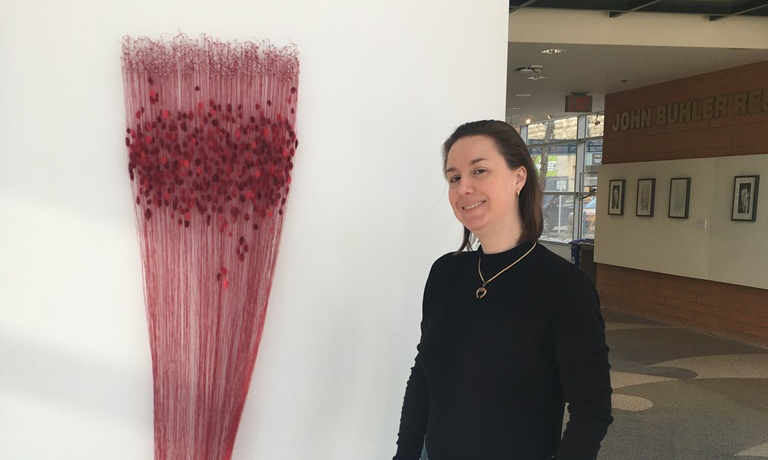
Dr. Sari Hannila with a fibre-art representation of blood clots.
Neurocraft: Exhibit explores the art and science of the brain
What are you afraid of?
For artist Peter Tittenberger, the answer is a creepy-crawly thing, something slimy, and it has tentacles and spines. It’s a quiet kind of creature, the sort of sea animal you don’t even know is there until it’s too late… You wade into the cool ocean waves and suddenly there’s something there in the water and what is that? Is there something touching your leg? Get it off! GET IT OFF!!!
If you feel a little unsettled now, that’s your thalamus talking. Amongst other things, it’s responsible for regulating emotion—including the fear that something might be waiting for you under the water.
Tittenberger is one of nine visual artists paired with a neuroscientist to explore the mysteries of the human mind—including fear—that culminated in a visual art exhibition called “Neurocraft.”
On now in the John Buhler Research Centre atrium, Neurocraft is the brain-child (sorry!) of Dr. Sari Hannila, Assistant Professor, Human Anatomy and Cell Science, Max Rady College of Medicine and Director of Outreach for the Manitoba Neuroscience Network. It’s her job to help bridge the gap between the public and the lab.
“I think that it can be a little intimidating when people hear scientists talk about their work,” said Hannila, a Rady Faculty of Health Sciences researcher focused on spinal cord injuries and effective treatment for neurodegenerative disorders such as multiple sclerosis and Alzheimer’s disease. “They may feel that they’re going to ask a stupid question, that they’re going to look foolish in front of people they perceive to be very intelligent, very accomplished, very educated. And we don’t want that—we want science to be accessible. We want people to be comfortable asking us these questions.”
By using visual art to explore complex ideas, Hannila says a whole new avenue opens up for conversation, giving a common starting point that feels comfortable whether you’re a medical specialist or a layperson. “I felt that craft especially would be a good way to connect with people because it deals with everyday materials and everyday objects, but in the most beautiful forms,” said Hannila, who credits a partnership with the Manitoba Craft Council for helping bring the concept to life.
In addition to Tittenberger’s otherworldly mixed-medium sculptures, the exhibition also includes fibre art, prints and video. “Art connects with people on an emotional level,” said Hannila. “So, that was the genesis of the idea.”
Once she had groups of willing participants from both the science community and the art world, she paired them up by interests and set them loose. “I never said to any of the artists or the scientists, this is the message that we want to convey, we want you to do this,” recalls Hannila. “It was, ‘you two go and talk, get to know each other, tell each other about what you do. And then see what comes out of it.’”
In the case of Dr. Mike Jackson and Lesley Nakonechny, the starting point was Alzheimer’s disease. Nakonechny used family portraits to create an initial print, starting with images of two men. As you view the second image of each man, you see that the picture is starting to decay—an effect created when the artist deliberately damaged the plate. By the third and final print, the man you see is fractured, still recognizable but indistinct. It’s the perfect metaphor for the fading we associate with Alzheimer’s disease, but if you take a moment to read the artist’s statement, you’ll realize there’s something even more powerful going on. The man on the left is Nakonechny’s grandfather. The one on the right is Jackson’s dad.
“I wasn’t expecting it to go to that level,” said Hannila, talking about the personal connection that the partnership created. When she paired the two, she knew only that Nakonechny had a family member with the disease. Jackson was involved in the project because of his role in the Rady Faculty of Health Sciences, where he’s an Assistant Professor, Pharmacology & Therapeutics, Max Rady College of Medicine.
The fact that Jackson’s family was personally affected added a surprise element for Hannila, one which brought a whole new meaning to the collaboration. “I think there was a lot of truth and authenticity in the pieces that came out of it. And I think that’s why they’re so powerful.”
Hannila is hoping that exhibits like Neurocraft will offer the public a glimpse into the kind of work that’s going on in the quiet offices and busy labs at the University of Manitoba and Health Sciences Centre where research takes place. But she says making that connection back to patients and their families can serve as an important reminder to the medical profession about why they got started in the first place.
“It’s very easy to start following a path and get drawn into all the fascinating questions that come out of it,” she said. “Every once in a while we need to be pulled back and reminded, ‘Okay, that was interesting, but remember, there are people who need our help here. We can never forget the reason why we’re doing this.’”
Neurocraft ran March 3 – 21, 2017 in the John Buhler Research Centre Atrium, 715 McDermot Avenue at the University of Manitoba Bannatyne Campus. The exhibit is now closed.






